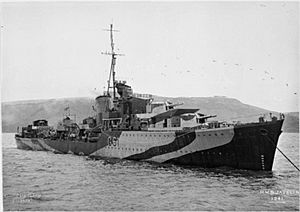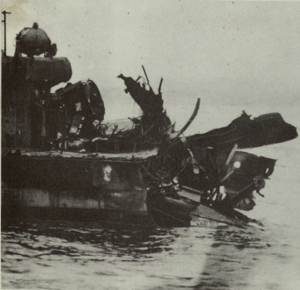HMS Javelin facts for kids
class="infobox " style="float: right; clear: right; width: 315px; border-spacing: 2px; text-align: left; font-size: 90%;"
| colspan="2" style="text-align: center; font-size: 90%; line-height: 1.5em;" | 
|} HMS Javelin was a fast warship called a destroyer. It was part of the Royal Navy, the United Kingdom's navy. Javelin was known for its speed and powerful weapons. It played a role in several important events during World War II.
Contents
| History | |
|---|---|
| Name | Javelin |
| Builder | John Brown and Company |
| Laid down | 11 October 1937 |
| Launched | 21 December 1938 |
| Commissioned | 10 June 1939 |
| Identification | Pennant number: F61 |
| Fate | Sold for scrap, 11 June 1949 |
| General characteristics (as built) | |
| Class and type | J-class destroyer |
| Displacement | |
| Length | 356 ft 6 in (108.7 m) (o/a) |
| Beam | 35 ft 9 in (10.9 m) |
| Draught | 12 ft 6 in (3.8 m) (deep) |
| Installed power |
|
| Propulsion | 2 × shafts; 2 × geared steam turbines |
| Speed | 36 knots (67 km/h; 41 mph) |
| Range | 5,500 nmi (10,200 km; 6,300 mi) at 15 knots (28 km/h; 17 mph) |
| Complement | 183 |
| Sensors and processing systems |
ASDIC |
| Armament |
|
Building and Early Service of HMS Javelin
Javelin was built by a company called John Brown and Company in Clydebank, Scotland. Its construction started on October 11, 1937. The ship was launched into the water on December 21, 1938. Finally, it officially joined the Royal Navy on June 10, 1939. Its special identification number was F61.
Helping at Dunkirk
In May 1940, Javelin took part in Operation Dynamo. This was a huge effort to rescue Allied soldiers from the beaches of Dunkirk, France. Javelin and other destroyers helped save many people from sinking ships.
Battles and Damage in World War II
Facing German Destroyers
In November 1940, Javelin was part of a group of five destroyers. This group, led by Captain Lord Louis Mountbatten, was operating near Plymouth, England. They met three German destroyers in a fierce battle.
During this fight, Javelin was hit badly by German gunfire and torpedoes. It lost both its front (bow) and back (stern) sections. Only about 47 meters (155 feet) of the ship remained afloat. Despite the severe damage, Javelin was towed back to port. It took almost a year to repair the ship.
Operations in the Mediterranean
After repairs, Javelin returned to action. In May 1942, it helped with Operation Ironclad. This was an attack on Madagascar to prevent it from falling into enemy hands.
In June 1942, Javelin was part of Operation Vigorous. This mission tried to deliver supplies to Malta, which was under siege. The mission faced strong enemy resistance and was not successful.
In January 1943, Javelin and another ship, HMS Kelvin, destroyed a group of small Italian ships. This happened during a night battle near Tripoli.
Later Years and Fate
Challenges on Board
After the war, in October 1945, an issue arose on Javelin while it was near Rhodes. Some sailors who had joined only for the war were unhappy about returning to strict pre-war rules. This led to some difficulties with discipline on the ship.
End of Service
Javelin was sold to companies that break up old ships on June 11, 1949. It was then taken to Troon, Scotland, to be scrapped.
See also
- Henry Leach (He was a navigating officer on Javelin during the time of the discipline issues.)


